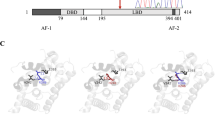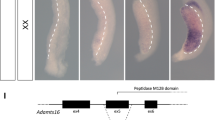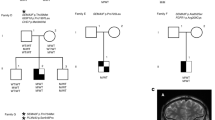Abstract
The incidence of impaired testicular descent (cryptorchidism) is high; 1–2% of boys at the age of 3 mo are diagnosed for this condition in western countries. Recent data on mice with targeted disruption of the Insl3/relaxin-like factor (RLF) gene proposed that this factor plays a role in testicular descent in fetal life. Male RLF−/− mice exhibit bilateral cryptorchidism due to developmental abnormalities of the gubernaculum, associated with abnormal spermatogenesis and infertility. In the present study, we have sequenced the promoter region and both exons of the RLF gene in a cohort of 30 boys, seven of whom presented with a possible familial form of cryptorchidism and 23 with sporadic cryptorchidism. One of the nucleotide substitutions detected, G to A at position 178, predicted amino acid change. The mutation was localized to the C-peptide region, resulting in an alanine to threonine change and therefore classified as a conservative mutation. Four of the 30 cases analyzed were homozygous (13%), and 15 were heterozygous for the mutation (50%). However, the same mutation was also found in a control group of 89 men; 10% of them were homozygous, and 39% were heterozygous. Our results indicate that mutations in the RLF gene are not a common reason for cryptorchidism and that the common G178A polymorphism has no apparent relationship with this condition.
Similar content being viewed by others
Main
Cryptorchidism or maldescent of the testis is a common congenital abnormality of the male genitourinary system, occurring in 2–5% of full-term boys at birth in Western countries. By 3 mo of age, the incidence rate spontaneously reduces to 1–2% in this group (1). Men with testicular maldescent have a 4 to 5-times higher risk of testicular cancer than the male population in general (2). Cryptorchidism is also associated with infertility and subfertility. It can be considered a cause of infertility in 2–9% of infertile patients (3, 4). Among patients treated for unilateral undescended testis, paternity rates of 70–87% have been reported, which is not different from the general population, whereas, in men treated for bilateral nondescent, paternity rates of only 30–53% have been found (5–7).
The etiology of cryptorchidism is unknown in most cases, but hypospadias, low birth weight, being first-born, cesarean section, and toxemia of pregnancy have been reported to be risk factors (8, 9). An almost 4-fold risk of cryptorchidism has been observed when an older brother has had a record of cryptorchidism (9), suggesting that in some cases this condition may have genetic reasons. Some genes putatively involved in cryptorchidism have been recently identified, including a homeobox gene, HOXA10, and the RLF gene.
RLF, also referred to as Leydig insulin-like (Ley-I-L or INSL3) peptide, is a novel member of the insulin/IGF/relaxin family of hormones and growth factors (10). The human RLF cDNA encodes a 131-amino acid precursor polypeptide comprising a signal peptide followed by B-, C-, and A-peptide domains, a structure similar to those of insulin and relaxin (11). RLF appears to be predominantly expressed in the testicular Leydig cells, but it is also found at low levels in the ovary and trophoblast (12). Chemically synthesized human RLF peptide has been shown to interact with a still uncharacterized specific receptor protein in human and mouse uterus and in mouse brain (13). This single subunit receptor shares similar features with the relaxin receptor, thus differing from insulin and IGF-1 receptors composed of multiple subunits. The sites of RLF expression, its potential target tissues, and features of its receptor support the relaxin-like characteristics of this factor (14, 15).
Despite intensive studies, the function of RLF has remained elusive until very recently, when the phenotype of the RLF/Insl3 knockout mice was reported (16, 17). The RLF-deficient mice indicated a role for this peptide in testicular descent. The male RLF−/− mice exhibited bilateral cryptorchidism associated with developmental abnormalities of the gubernaculum, abnormal spermatogenesis, and infertility. The female homozygous mice had impaired fertility associated with deregulation of the estrus cycle. Hence, the findings on male mice deficient of RLF propose that it could be one of the factors involved in testicular descent.
To study the possible occurrence of RLF mutations in cryptorchidism, we have analyzed the RLF gene sequence in a group of cryptorchid boys with possible familial cause of the condition, in cryptorchid boys without family history of cryptorchidism, and in a representative group of male controls.
METHODS
Patients and control samples.
All 30 patients were born in Turku University Central Hospital and, except for one, were diagnosed as cryptorchid at birth and again at the age of 3 mo. One patient was not diagnosed as cryptorchid until the age of 18 mo. None of the patients was born preterm. All patients were examined again at the age of 3 mo and were/will be followed up until the age of 18 mo.
The family history of cryptorchidism was inquired from the parents. A cryptorchid first-degree relative was found in families of seven patients. Blood samples from patients were collected at the age of 3 mo or during orchidopexy. Control blood samples were obtained from a collection of random Finnish population samples (Finnish Red Cross). The study was approved by the local Ethics Committee. Informed consent from the parents was obtained before enrollment of the children in the study.
DNA isolation and PCR.
DNA was isolated from blood samples by the salting-out method (17a). One hundred nanograms of the DNA was subjected to PCR in a total volume of 50 μL. The PCR reaction contained 1 U Taq polymerase (DyNAZyme II; Finnzymes, Espoo, Finland), 0.1 mM deoxynucleotide triphosphates, 0.5 μmol/L of both forward and reverse primers in reaction buffer (10 mM Tris-HCl pH 8.8, 1.5 mM MgCl2, 50 mM KCl, 0.1% Triton X-100). After the first denaturation cycle (95°C for 2 min), 35 cycles of amplification were run, defined by denaturation at 95°C for 40 s, annealing at 65°C for 1 min, and extension at 72°C for 1 min.
Oligonucleotide primers 5a (5′-GACTCGTTGCCCAGTGCTCCCTC) and 3a (5′-GCACCTGCCCCACCTCGGACTT) were used to amplify a 446-bp fragment that included a 202-bp-long promoter region upstream of the translation initiation codon, together with the 190-bp-long exon 1 and 54 bp of intron (Fig. 1). The second exon was amplified with 5b (5′-TGGGGTAGCATGTCCTCTGTCGTT) and 3b (5′-AGGCCTGTAGATGCGAGACTTTATGGT) primers. This generated a 365-bp fragment including a small part of intron (56 bp), 206-bp-long exon 2 (until stop codon), and 103 bp of the 3′-flanking region. After PCR, the DNA was resolved by electrophoresis on a 1.5% agarose gel, and the DNA fragments were purified with the GFX DNA purification kit (Amersham Pharmacia Biotech).
Structure of the RLF gene and strategy for PCR amplification. Two RLF exons are shown by numbered boxes. Primers used for PCR and sequencing are indicated by arrows. Mutation at position 178 is marked with the asterisk. The wild-type sequence has a restriction site for the Eag I restriction enzyme. Two binding sites for SF-1 are shown by circles.
Sequencing and sequence analysis.
DNA samples were sequenced using a fluorescent dye terminator reaction (Prism Ready Reaction Dye Termination Cycle Sequencing Kit, Perkin-Elmer, Foster City, CA) and automated sequencer (Perkin-Elmer). The same PCR primers were used to sequence both strands, and all mutations were confirmed with a new PCR sample. Sequence comparisons were constructed with the DNASTAR software package (DNASTAR, Madison, WI).
Restriction fragment length polymorphism (RFLP).
The PCR products obtained with primers 5a and 3a were also used as templates for RFLP assay. Eag I restriction enzyme, specific for the wild-type sequence at position 178, was used in the assay. After digestion of the PCR products with restriction enzyme, the restriction fragments obtained were analyzed on a 2% agarose gel.
Statistical analysis.
The χ2 test was performed to evaluate a significant difference between controls and cryptorchid patients.
RESULTS
Sequence analysis.
In the first phase of the study, DNA samples from seven cryptorchid boys with possible familial cause, i.e. their first-degree relative had been cryptorchid, were chosen to be amplified and sequenced with RLF gene-specific primers. In addition, 23 DNA samples from cryptorchid boys without family history of this condition were sequenced.
A 202-bp-long RLF 5′-prime promoter fragment was sequenced. Our in vitro studies indicate that this region comprises the most important elements for transcription (18, 19). However, sequence comparisons of this proximal promoter region did not show any changes in the nucleotide sequence in cryptorchid boys. In contrast, the sequence of exon 1 revealed a single-base substitution G to A at position 178. This nucleotide substitution causes amino acid change from alanine to threonine in the region encoding the C-peptide. Of the 30 samples of cryptorchid boys analyzed, four carried a homozygote and 15 heterozygote substitutions, resulting in 38.3% allele frequency (Table 1). Two additional mutations were found at positions 27 (G to A) and 126 (G to A), but they did not result in any amino acid changes. G27A mutation was found in four heterozygous and G126A mutation in 16 heterozygous and in 9 homozygous out of 30 cryptorchid cases.
The nucleotide sequence from the region containing exon 2 revealed no changes in the 30 samples analyzed.
RFLP analysis.
To characterize whether the identified G178A mutation is linked with cryptorchidism or whether it represents a common polymorphic allele, RFLP analysis was performed. For this reason, 89 random DNA samples from the Finnish population were subjected to restriction enzyme Eag I digestion. The enzyme does not have a restriction site in the homozygous mutation, and thus only one 446-bp fragment is generated. In the case of heterozygous mutation, three fragments were generated, 446 bp, 378 bp, and 68 bp, whereas only two fragments, 378 bp and 68 bp, were seen in wild-type alleles (Fig. 2). Digestion with Eag I revealed that nine control cases were homozygous and 35 were heterozygous for the mutation, resulting in 30% allele frequency for the mutation (Table 1). This result indicates that the G178A substitution is a common polymorphism among normal men.
RFLP analysis. Eag I digestion of the PCR-amplified fragment from exon 1 of the RLF gene. DNA molecular weight markers are shown in lanes 1 and 7. Lanes 2 and 3 represent samples from individuals of wild-type allele;lanes 4 and 5, samples of heterozygous allele;lane 6, sample of homozygous allele for G178A mutation. The sizes of the DNA marker fragments are indicated on the left, and sizes of the fragments from Eag I digestion are shown on the right.
DISCUSSION
Some cryptorchid cases are considered familial in origin. This hypothesis is supported by studies in which the risk of cryptorchidism is 4-fold higher when a brother has a record of cryptorchidism (8). The cause may be a defect in the gene(s) involved in testicular descent. Knockout studies of murine HOXA10 and RLF genes demonstrate cryptorchidism in male mice mutants for these genes (16, 17, 20, 21). This proposed a role for HOXA and RLF genes in testicular descent, and, hence, mutations of these genes are considered putative causes of cryptorchidism also in humans. Kolon et al. (22) analyzed the homeobox gene HOXA10 mutations in cryptorchidism and demonstrated genetic alterations in some cryptorchid boys. However, no clear connection between the mutations and cryptorchidism was found.
In our study, we chose the RLF gene as a candidate gene to analyze its possible mutations in cryptorchid men. In addition to the coding regions of the two exons of the RLF gene, we also analyzed the first 202 bp of the promoter region. Among this region, there are two binding sites for the steroidogenic factor-1 (SF-1). By use of promoter analyses in vitro, SF-1-binding regions have been shown to be important for regulation of the mouse RLF gene (19); Koskimies P, unpublished results). The fact that sequence comparisons of this region in the human RLF did not show any nucleotide substitutions emphasizes the importance of this regulatory area for expression of the RLF gene.
In the present study, only one mutation causing amino acid change was found in the coding region of the RLF gene. This single-base G to A substitution at position 178 of exon 1 is in the region encoding the C-peptide. The mutation causes an amino acid change from alanine to threonine and, therefore, is classified as a conservative mutation. As no structure-function analysis is available, the possible functional effects of this mutation are unknown. It is known that C-peptide functions as a connective link between the A- and B-peptides during folding of the mature protein (23). It is also possible that C-peptide is cleaved out of the mature peptide, and, indeed, it has been shown that a chemically synthesized A-B heterodimer interacts with the RLF receptors (13, 15). This suggests that the structure of C-peptide can be important during folding of the RLF protein but not for function of the mature peptide.
The cryptorchid boys analyzed had the G178A mutation (in hetero- or homozygous forms) with allele frequency slightly but not significantly higher (38.3%) than in the control population (29.7%). However, the high frequency of the mutation in normal men points to its polymorphic nature. Moreover, we did not find any correlation between this mutation and the cases with possible familial cryptorchidism. These findings suggest that there is a common polymorphism in the human RLF gene at position 178 (Ala60Thr), which is not linked to cryptorchidism.
Abbreviations
- RLF:
-
relaxin-like factor
References
Toppari J, Kaleva M 1999 Maldescendus testis. Horm Res 51: 261–269.
Giwercman A, Grindsted J, Hansen B, Jensen OM, Skakkebaek NE 1987 Testicular cancer risk in boys with maldescended testis: a cohort study. J Urol 138: 1214–1216.
Abyholm T, Oian P, Gordeladze JO 1986 True cryptorchidism and retractile testes in infertile men. Acta Eur Fertil 17: 15–18.
Carizza C, Antiba A, Palazzi J, Pistono C, Morana F, Alarcon M 1990 Testicular maldescent and infertility. Andrologia 22: 285–288.
Cendron M, Keating MA, Huff DS, Koop CE, Snyder HM III, Duckett JW 1989 Cryptorchidism, orchiopexy, and infertility: a critical long-term retrospective analysis. J Urol 142: 559–569.
Lipschultz L, Caminos-Torres R, Greenspan C, Snyder P 1976 Testicular function after orchidopexy for unilaterally undescended testis. N Engl J Med 295: 15–18.
Lee P, O'Leary L, Songer N, Bellinger M, LaPorte R 1995 Paternity after cryptorchidism: lack of correlation with age at orchidopexy. Br J Urol 75: 704–707.
Weidner IS, Moller H, Jensen TK, Skakkebaek NE 1999 Risk factors for cryptorchidism and hypospadias. J Urol 161: 1606–1609.
Hjertkvist M, Damber JE, Bergh A 1989 Cryptorchidism: a registry-based study in Sweden on some factors of possible aetiological importance. J Epidemiol Community Health 43: 324–329.
Ivell R 1997 Biology of the relaxin-like factor (RLF). Rev Reprod 2: 133–138.
Burkhardt E, Adham IM, Hobohm U, Murphy D, Sander C, Engel W 1994 A human cDNA coding for the Leydig insulin-like peptide (Ley I-L). Hum Genet 94: 91–94.
Tashima LS, Hieber AD, Greenwood FC, Bryant-Greenwood GD 1995 The human Leydig insulin-like (hLEY I-L) gene is expressed in the corpus luteum and trophoblast. J Clin Endocrinol Metab 80: 707–710.
Bullesbach EE, Schwabe C 1995 A novel Leydig cell cDNA-derived protein is a relaxin-like factor. J Biol Chem 270: 16011–16015.
Bullesbach EE, Rhodes R, Rembiesa B, Schwabe C 1999 The relaxin-like factor is a hormone. Endocrine 10: 167–169.
Bullesbach EE, Schwabe C 1999 Specific, high affinity relaxin-like factor receptors. J Biol Chem 274: 22354–22358.
Zimmermann S, Steding G, Emmen JM, Brinkmann AO, Nayernia K, Holstein AF, Engel W, Adham IM 1999 Targeted disruption of the Insl3 gene causes bilateral cryptorchidism. Mol Endocrinol 13: 681–691.
Nef S, Parada LF 1999 Cryptorchidism in mice mutant for Insl3. Nat Genet 22: 295–299.
Miller SA, Dykes DD, Polesky HF 1988 A simple salting out procedure for extracting DNA from human nucleated cells. Nucleic Acid Res 16: 1215
Koskimies P, Spiess AN, Lahti P, Huhtaniemi I, Ivell R 1997 The mouse relaxin-like factor gene and its promoter are located within the 3′ region of the JAK3 genomic sequence. FEBS Lett 419: 186–190.
Zimmermann S, Schwarzler A, Buth S, Engel W, Adham IM 1998 Transcription of the Leydig insulin-like gene is mediated by steroidogenic factor-1. Mol Endocrinol 12: 706–713.
Satokata I, Benson G, Maas R 1995 Sexually dimorphic sterility phenotypes in Hoxa10-deficient mice. Nature 374: 460–463.
Rijli FM, Matyas R, Pellegrini M, Dierich A, Gruss P, Dolle P, Chambon P 1995 Cryptorchidism and homeotic transformations of spinal nerves and vertebrae in Hoxa-10 mutant mice. Proc Natl Acad Sci USA 92: 8185–8189.
Kolon TF, Wiener JS, Lewitton M, Roth DR, Gonzales ET Jr, Lamb DJ 1999 Analysis of homeobox gene HOXA10 mutations in cryptorchidism. J Urol 161: 275–280.
Bullesbach EE, Schwabe C 1999 Tryptophan B27 in the relaxin-like factor (RLF) is crucial for RLF receptor-binding. Biochemistry 38: 3073–3078.
Author information
Authors and Affiliations
Additional information
Supported by grants from Academy of Finland, Finnish Environmental Health Research Programme, and Turku University Central Hospital.
Rights and permissions
About this article
Cite this article
Koskimies, P., Virtanen, H., Lindström, M. et al. A Common Polymorphism in the Human Relaxin-Like Factor (RLF) Gene: No Relationship with Cryptorchidism. Pediatr Res 47, 538–541 (2000). https://doi.org/10.1203/00006450-200004000-00020
Received:
Accepted:
Issue Date:
DOI: https://doi.org/10.1203/00006450-200004000-00020
This article is cited by
-
The G178A polymorphic variant of INSL3 may be linked to cryptorchidism among Egyptian pediatric cohort
Pediatric Surgery International (2020)
-
Genetic analysis of the human insulin-like 3 gene in pediatric patients with testicular torsion
Pediatric Surgery International (2018)
-
Testicular descent: INSL3, testosterone, genes and the intrauterine milieu
Nature Reviews Urology (2011)
-
Paracrine and endocrine roles of insulin-like factor 3
Journal of Endocrinological Investigation (2006)
-
Cryptorchidism: an indicator of testicular dysgenesis?
Cell and Tissue Research (2005)





